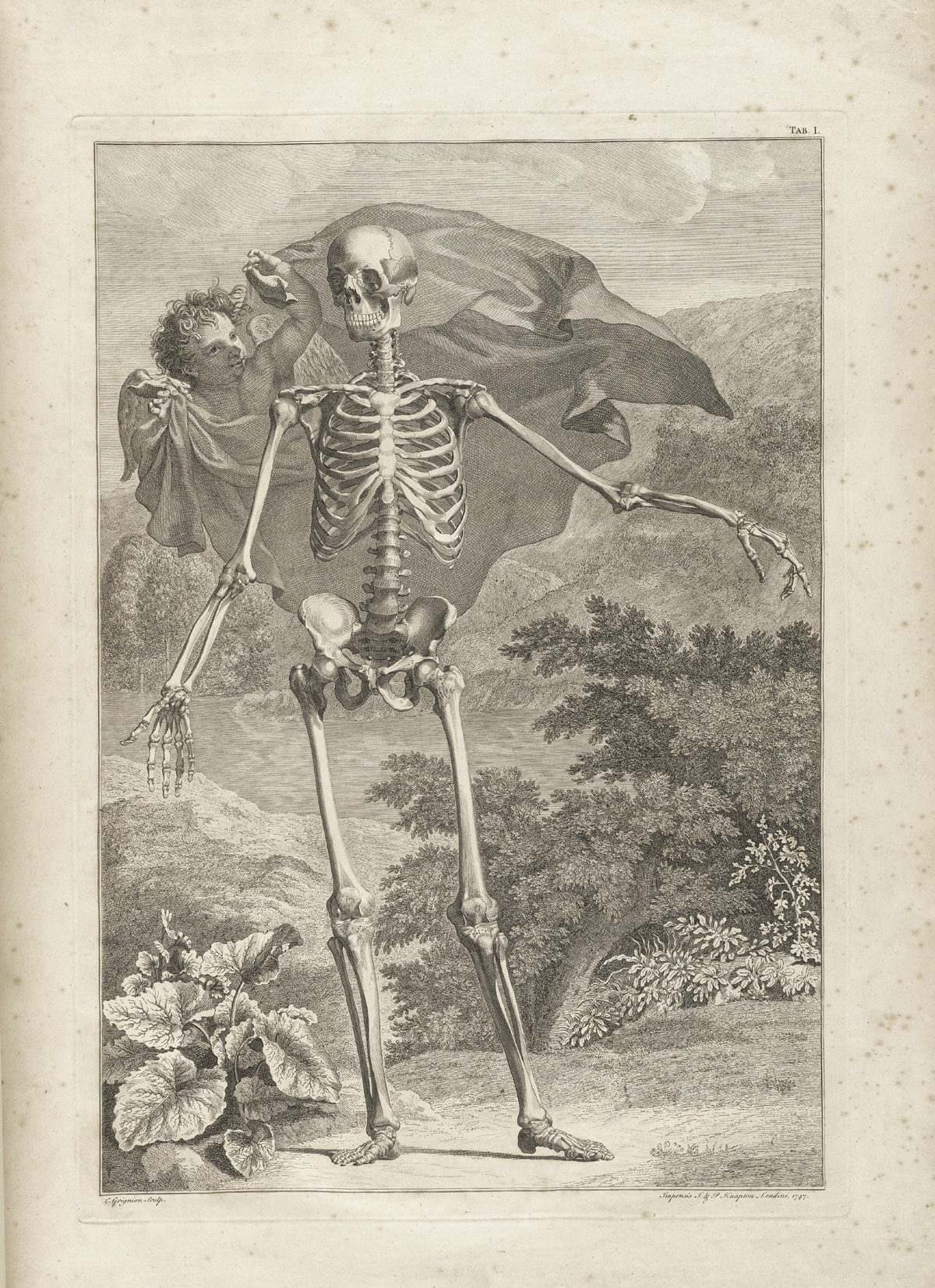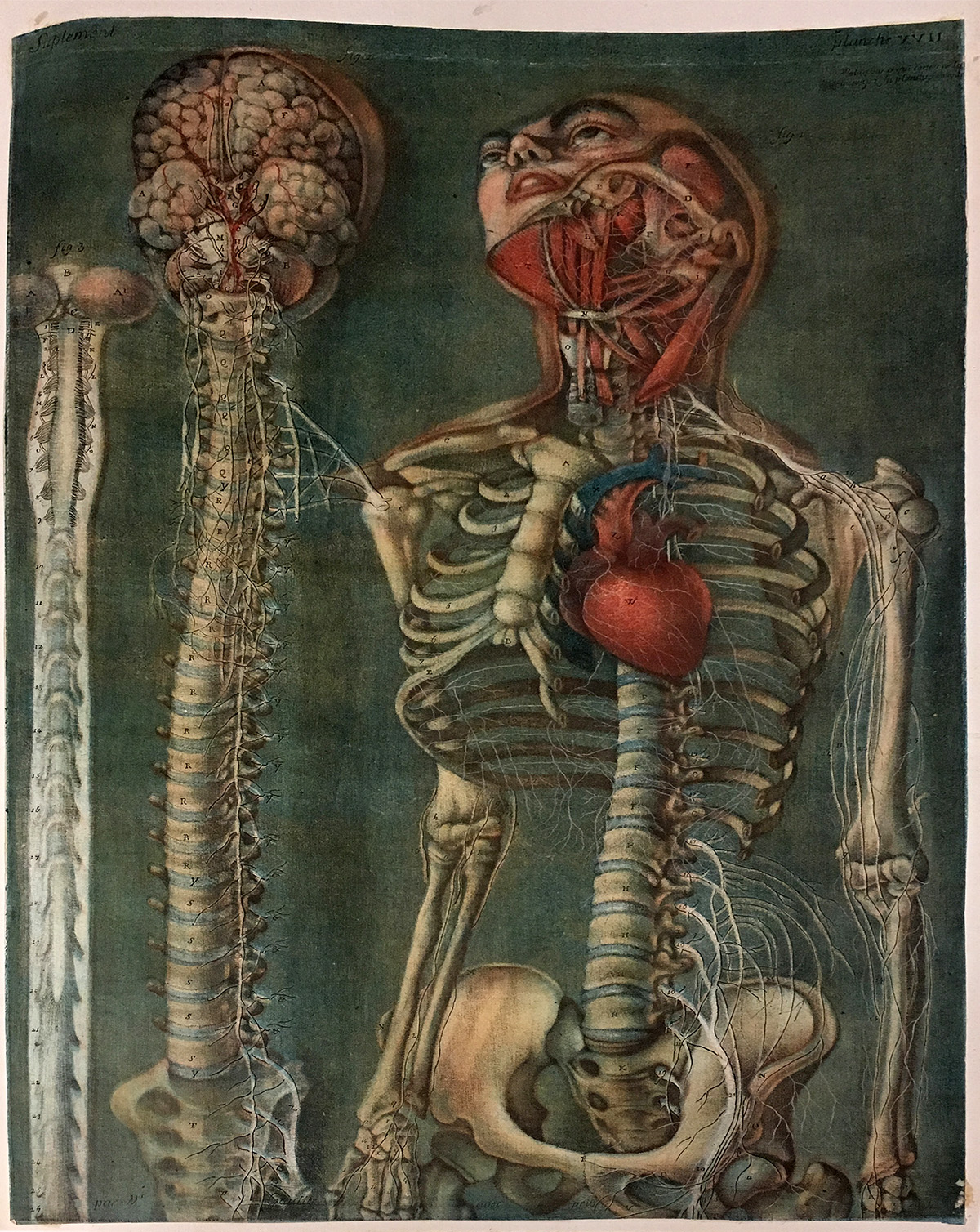
Enlightenment publications on human anatomy changed the way artists understood their place in the world. Check out these examples of life-changing images brought to you by prints in books! In s2e31 of Platemark’s History of Prints series, Tru...
Enlightenment publications on human anatomy changed the way artists understood their place in the world. Check out these examples of life-changing images brought to you by prints in books!
In s2e31 of Platemark’s History of Prints series, Tru and Ann continue their discussion of the Enlightenment. This time they look at several publications that put forward new discoveries about human anatomy: William Hunter’s The Anatomy of the Human Gravid Uterus, Bernhard Siegfried Albinus’ Tabulae sceleti et musculorum corporis humani, and Jacques Fabien Gautier d’Agoty’s Myologie complette en couleur et grandeur naturelle. They conclude with Denis Diderot’s Encyclopédie, ou dictionnaire raisonné des sciences, des arts et des métiers, a 17-volume tome that attempted to define and codify all of human knowledge.
At the end of the episode, Ann and Tru wax philosophical about how incredible this blossoming of human knowledge is, and how talking about it makes each of them think about our place as humans on the planet. It gets a bit deep, but worthwhile.
A. Hadamart. Exhibition of the Royal Academy of Painting and Sculpture in the Grande Galerie of the Louvre, 1699. Engraving.
Gabriel de Saint-Aubin (French, 1724–1780). Vue du Louvre en l’année 1753, 1753. Etching. Plate: 5 13/16 x 7 1/8 in. (14.8 x 18.1 cm.); sheet: 6 ¼ x 7 5/8 in. (15.8 x 19.3 cm.). Metropolitan Museum of Art, New York.
Pietro Antonio Martini (Italian, 1738–1797). View of the Salon of 1785, 1785. Etching. Plate: 10 7/8 x 19 1/8 in. (27.6 x 48.6 cm.); sheet: 14 1/4 x 20 3/4 in. (36.2 x 52.7 cm.). Metropolitan Museum of Art, New York.
Pietro Antonio Martini (Italian, 1738–1797). View of the Salon of 1787, 1787. Etching. Plate: 12 11/16 x 19 5/16 in. (32.2 x 49.1 cm.); sheet: 14 x 19 3/4 in. (35.6 x 50.2 cm.). Metropolitan Museum of Art, New York.
Pietro Antonio Martini (Italian, 1738–1797), after Johann Heinrich Ramberg (German, 1763–1840). The Exhibition of the Royal Academy 1787, 1787. Engraving. Plate: 36.1 x 49.9 cm. British Museum, London.
Jacques-Louis David (French, 1748–1825). The Oath of the Horatii, 1784/85. Oil on canvas. 10.8 x 13.9 ft. Louvre Museum, Paris.
Sir Joshua Reynolds (British, 1723–1792). Lady Sarah Bunbury Sacrificing to Graces, 1765. Oil on canvas. 242.6 × 151.5 cm. (95 1/2 × 59 3/4 in.). Art Institute of Chicago.
Sir Joshua Reynolds (British, 1723–1792). Lord Heathfield of Gibraltar, 1787. Oil on canvas. 142 x 113.5 cm. National Gallery, London.
Pietro Antonio Martini (Italian, 1738–1797). Salon de 1787: view of the Salon Carre at the Louvre during the painting exhibition in Paris, 1852. Engraving. From Frank Leslie’s Popular Monthly.
Jean-Antoine Houdon (French, 1741–1828). Voltaire Seated, 1781. Terra-cotta. 120 cm. tall. Musée Fabre, Montpellier.
Jean Honoré Fragonard (French, 1732–1806). Les hasards heureux de l’escarpolette (The Swing), c. 1767–68. Oil on canvas. 81 x 64.2 cm. The Wallace Collection, London.
Jean-Antoine Houdon (French, 1741–1828). Benjamin Franklin, 1778. Marble. 23 1/8 × 14 1/2 × 11 1/4 in. Metropolitan Museum of Art, New York.
Rembrandt (Dutch, 1606–1669). The Anatomy Lesson of Dr. Nicolaes Tulp, 1632. Oil on canvas. 216.5 × 169 ½ cm. (85 1/4 × 66 5/8 in.). Mauritshuis, The Hague.
William Hunter (British, 1718–1783). Title page from The Anatomy of the Human Gravid Uterus. Birmingham: John Baskerville, 1774.
Jan van Rymsdyk (Dutch, c. 1730–1790). Plate VI from The Anatomy of the Human Gravid Uterus. London: S. Baker & G. Leigh, 1774. Engraving.
Leonardo da Vinci (Italian, 1452–1519). Sketchbook page: the fetus in the womb, c. 1511. Black and red chalk, pen and brush and ink. The Royal Collection.
Leonardo da Vinci (Italian, 1452–1519). Sketchbook page: the female genetalia and fetus in the womb, c. 1511. Black and red chalk, pen and brush and ink. The Royal Collection.
Johann Zoffany (German, 1733–1810). William Hunter Lecturing, 1770–72. Oil on canvas. Royal College of Physicians, London.
Roman copy of Greek marble. The Dying Gaul, late 3rd century BCE. Marble. Capitoline Museums, Rome.
William Pink (British, 1809–1857), after Agostini Carlini (British, born Italy, c. 1718–1790). Smugglerius, c. 1834. Plaster. Royal Academy of Arts, London.
Thomas Banks (British, 1735–1805). Anatomical Crucifixion (James Legg), 1801. Plaster cast. Royal Academy of Arts, London.
Bernhard Siegfried Albinus (Dutch, born German, 1697–1770). Title page from Tabulae sceleti et musculorum corporis humani. London: H. Woodfall, 1749.
Bernhard Siegfried Albinus (Dutch, born German, 1697–1770). Page from Tabulae sceleti et musculorum corporis humani. London: H. Woodfall, 1749.
Bernhard Siegfried Albinus (Dutch, born German, 1697–1770). Page from Tabulae sceleti et musculorum corporis humani. London: H. Woodfall, 1749.
Bernhard Siegfried Albinus (Dutch, born German, 1697–1770). Page from Tabulae sceleti et musculorum corporis humani. London: H. Woodfall, 1749.
Bernhard Siegfried Albinus (Dutch, born German, 1697–1770). Page from Tabulae sceleti et musculorum corporis humani. London: H. Woodfall, 1749.
Jacques Fabien Gautier d’Agoty (French, 1716–1785). Plate from Myologie complette en couleur et grandeur naturelle. Paris: Gautier, Quillau, Lamesle, 1746.
Jacques Fabien Gautier d’Agoty (French, 1716–1785). Plate from Myologie complette en couleur et grandeur naturelle. Paris: Gautier, Quillau, Lamesle, 1746.
Leonardo da Vinci (Italian, 1452–1519). Sketchbook page, c. 1511. Black and red chalk, pen and brush and ink. The Royal Collection.
Jacques Fabien Gautier d’Agoty (French, 1716–1785). Plate from Anatomy of the head, in printed images, representing the natural appearance of the brain at different levels, the distribution of the vessels, the sensory organs and part of the nervous system; taken from dissected and prepared portions of the subjects, 1748. Wellcome Library Collection, London.
Jacques Fabien Gautier d’Agoty (French, 1716–1785). Plate from Exposition anatomique des organes des sens. Paris: Demonville, 1775.
Jacques Fabien Gautier d’Agoty (French, 1716–1785). Plate from Exposition anatomique des organes des sens. Paris: Demonville, 1775.
Jacques Fabien Gautier D'Agoty (1717–1785). Plate from Anatomie générale des viscères. Paris: 1752.
Jacques Fabien Gautier d’Agoty (French, 1716–1785). Plate from Anatomy of the head, in printed images, representing the natural appearance of the brain at different levels, the distribution of the vessels, the sensory organs and part of the nervous system; taken from dissected and prepared portions of the subjects, 1748. Wellcome Library Collection, London.
Jacques Fabien Gautier D'Agoty (1717–1785). Plate from Anatomie des parties de la génération de l'homme et de la femme. Paris, 1773.' Pregnant Woman
Jean-Antoine Houdon (French, 1741–1828). Denis Diderot (1713–1784), 1773. Marble. Height (bust): 15 3/4 in. (40 cm.); height (stand): 4 11/16 in. (11.9 cm.). Metropolitan Museum of Art, New York.
Denis Diderot (French, 1713–1784) and Jean le Rond d'Alembert (French, 1717–1783). Title page and frontispiece from Encyclopédie, ou dictionnaire raisonné des sciences, des arts et des métiers. Paris: André le Breton, Michel-Antoine David, Laurent Durant, and Antoine-Claude Briasson, 1751–72.
Denis Diderot (French, 1713–1784) and Jean le Rond d'Alembert (French, 1717–1783). Plate from Encyclopédie, ou dictionnaire raisonné des sciences, des arts et des métiers. Paris: André le Breton, Michel-Antoine David, Laurent Durant, and Antoine-Claude Briasson, 1751–72.
Anatomy pages from the Encyclopedia Britannia, 1963.
Flags pages from the Encyclopedia Britannia, 1963.
Denis Diderot (French, 1713–1784) and Jean le Rond d'Alembert (French, 1717–1783). Plate from Encyclopédie, ou dictionnaire raisonné des sciences, des arts et des métiers. Paris: André le Breton, Michel-Antoine David, Laurent Durant, and Antoine-Claude Briasson, 1751–72.
Denis Diderot (French, 1713–1784) and Jean le Rond d'Alembert (French, 1717–1783). Plate from Encyclopédie, ou dictionnaire raisonné des sciences, des arts et des métiers. Paris: André le Breton, Michel-Antoine David, Laurent Durant, and Antoine-Claude Briasson, 1751–72.
Denis Diderot (French, 1713–1784) and Jean le Rond d'Alembert (French, 1717–1783). Plate from Encyclopédie, ou dictionnaire raisonné des sciences, des arts et des métiers. Paris: André le Breton, Michel-Antoine David, Laurent Durant, and Antoine-Claude Briasson, 1751–72.
Denis Diderot (French, 1713–1784) and Jean le Rond d'Alembert (French, 1717–1783). Plate from Encyclopédie, ou dictionnaire raisonné des sciences, des arts et des métiers. Paris: André le Breton, Michel-Antoine David, Laurent Durant, and Antoine-Claude Briasson, 1751–72.
Denis Diderot (French, 1713–1784) and Jean le Rond d'Alembert (French, 1717–1783). Plate from Encyclopédie, ou dictionnaire raisonné des sciences, des arts et des métiers. Paris: André le Breton, Michel-Antoine David, Laurent Durant, and Antoine-Claude Briasson, 1751–72.
Denis Diderot (French, 1713–1784) and Jean le Rond d'Alembert (French, 1717–1783). Plate from Encyclopédie, ou dictionnaire raisonné des sciences, des arts et des métiers. Paris: André le Breton, Michel-Antoine David, Laurent Durant, and Antoine-Claude Briasson, 1751–72.
Denis Diderot (French, 1713–1784) and Jean le Rond d'Alembert (French, 1717–1783). Plate from Encyclopédie, ou dictionnaire raisonné des sciences, des arts et des métiers. Paris: André le Breton, Michel-Antoine David, Laurent Durant, and Antoine-Claude Briasson, 1751–72.
Denis Diderot (French, 1713–1784) and Jean le Rond d'Alembert (French, 1717–1783). Plate from Encyclopédie, ou dictionnaire raisonné des sciences, des arts et des métiers. Paris: André le Breton, Michel-Antoine David, Laurent Durant, and Antoine-Claude Briasson, 1751–72.
Denis Diderot (French, 1713–1784) and Jean le Rond d'Alembert (French, 1717–1783). Plate from Encyclopédie, ou dictionnaire raisonné des sciences, des arts et des métiers. Paris: André le Breton, Michel-Antoine David, Laurent Durant, and Antoine-Claude Briasson, 1751–72.
Denis Diderot (French, 1713–1784) and Jean le Rond d'Alembert (French, 1717–1783). Plate from Encyclopédie, ou dictionnaire raisonné des sciences, des arts et des métiers. Paris: André le Breton, Michel-Antoine David, Laurent Durant, and Antoine-Claude Briasson, 1751–72.
Denis Diderot (French, 1713–1784) and Jean le Rond d'Alembert (French, 1717–1783). Plate from Encyclopédie, ou dictionnaire raisonné des sciences, des arts et des métiers. Paris: André le Breton, Michel-Antoine David, Laurent Durant, and Antoine-Claude Briasson, 1751–72.
Denis Diderot (French, 1713–1784) and Jean le Rond d'Alembert (French, 1717–1783). Plate from Encyclopédie, ou dictionnaire raisonné des sciences, des arts et des métiers. Paris: André le Breton, Michel-Antoine David, Laurent Durant, and Antoine-Claude Briasson, 1751–72.
Denis Diderot (French, 1713–1784) and Jean le Rond d'Alembert (French, 1717–1783). Plate from Encyclopédie, ou dictionnaire raisonné des sciences, des arts et des métiers. Paris: André le Breton, Michel-Antoine David, Laurent Durant, and Antoine-Claude Briasson, 1751–72.
Francisco de Goya (Spanish, 1746–1828). Plate 43 from Los Caprichos: The sleep of reason produces monsters (El sueño de la razon produce monstruos), 1799. Etching and aquatint. Plate: 8 3/8 x 5 15/16 in. (21.2 x 15.1 cm.); sheet: 11 5/8 x 8 1/4 in. (29.5 x 21 cm.). Metropolitan Museum of Art, New York.
Platemark is produced by Ann Shafer
Theme music: Michael Diamond
Audio mixing: Dan Fury, Extension Audio
PR and Marketing: Elizabeth Berger, EYB Creates



























































